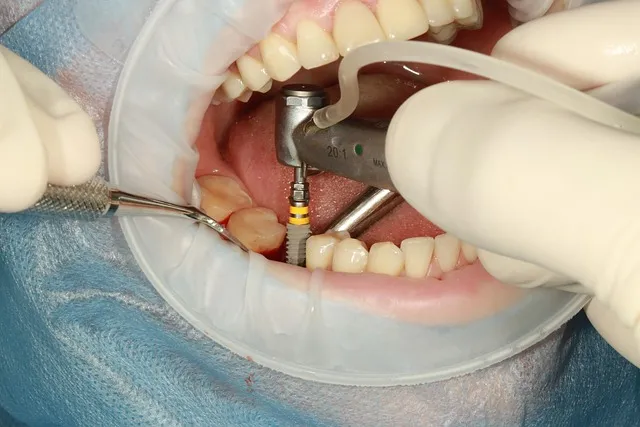A tooth extraction requires proper aftercare to ensure smooth healing and prevent complications like excessive bleeding or dry sockets. One of the most important steps is using gauze to control bleeding and promote clot formation—but how long should you keep it in place?
The exact duration depends on factors like the complexity of extraction, bleeding intensity, and individual healing speed. In this article, you’ll learn how long to keep gauze in after extraction, how to change it properly, when to stop using gauze, and additional essential aftercare tips for faster healing.
Let’s start!
How Long to Keep Gauze in After Tooth Extraction?
The duration for holding gauze post-tooth extraction is generally 30-45 minutes or as instructed by your dentist. You will be asked to bite it down by applying gentle pressure. According to a study, this pressure should be placed for about 5 minutes. It helps in controlling bleeding by forming a blood clot in the treated site.
Here are the other important things to consider:
-
Change gauze every 30-60 minutes in the first few hours of extraction, especially in case of active bleeding.
-
Don't remove the gauze very early as it can lead to clot displacing, resulting in excessive bleeding.
-
As the intensity of bleeding comes under control, you can discontinue gauze use.
-
More importantly, don’t put the gauze on for an extended period, as it can irritate the treated site and create further issues.
-
However, always discuss it with your dentist before doing that.
How to Change Gauze Properly
Changing gauze incorrectly can dislodge the blood clot and lead to excessive bleeding. Follow these steps to do it safely:
-
Wash your hands thoroughly to avoid introducing bacteria.
- Remove the old gauze gently (make sure not to pull blood clots). Avoid pulling if it sticks.
-
Prepare a fresh, folded gauze pad (or a damp tea bag, which can aid clotting)
-
Place the new gauze over the treated site and bite it down gently to apply pressure.
Avoid These Mistakes:
- Don’t remove gauze too soon—it can disrupt clot formation.
- Don’t wet the gauze with saliva or water, as it reduces its effectiveness.
- Don’t place excessive layers of gauze, as it may cause discomfort.
When to Stop Using Gauze After Tooth Extraction
Here are the signs indicating you can stop using gauze when:
-
Reduced Bleeding: If you see a slight blood in the gauze, it means the bleeding is under control.
-
Formation of Blood Clot: When you notice stable blood clots, it's time to safely remove gauze.
-
No More Pain or Discomfort: If there is no pain or discomfort at the treated site, it indicates you don't need gauze anymore.
-
No Longer Active Bleeding: If you don’t notice fresh blood while changing gauze, it's time to stop its use.
-
Secured Extraction Site: The treated area is no longer seen open or huge which is a sign that proper healing has started.
Note: If you notice pink saliva or a small amount of blood for 24-48 hours, it’s normal. But if bleeding persists or worsens, contact your dentist immediately.
Important: In case you're not sure about how long to let the gauze be in the extraction site for complication-free recovery, always reach out to your dentist.
Factors That Affect Gauze Usage Duration After Tooth Extraction
The time needed for gauze varies depending on:
-
Extent of the Tooth Extraction: More complex tooth extractions, for instance, impacted teeth) may lead to much more bleeding and need a longer use of gauze.
-
Individual Bleeding Rate: Some individuals might bleed more naturally compared to others, which may extend the use of gauze to manage it.
-
Clot Formation Rate: In case of quick blood clotting, you may require gauze for less time, while for slow blood clotting, it may take longer to keep it.
-
Surgical Techniques: If dentists use stitches to close the wound, you may be asked to keep gauze for a longer time. However, this duration can vary depending on the technique used.
-
Patient Activity: Excessive activity or movement can interrupt clot formation, extending gauze use.
Why Gauze is Essential After Tooth Extraction
Gauze plays a critical role in recovery. Here is why gauze is crucial after tooth extraction:
-
Controls Bleeding: By applying pressure to the treated site, gauze helps stop bleeding.
-
Helps Blood Clot Formation: Research reports the quick formation of blood clots with nonwoven cotton gauze. This promotes healing and wound protection.
-
Prevents Infection Risk: Keeps bacteria and debris away from an extraction site, which reduces infection risk.
-
Prevents Dry Socket: Ensures the blood clot remains in place, preventing dry socket, which causes pain and slows down recovery.
Overall, gauze is an essential tool for promoting healing post-extraction.
Warning: If bleeding persists beyond 24 hours or worsens, consult your dentist immediately.
Best Practices for a Smooth Recovery Post-Extraction
Follow these expert tips to ensure proper healing after extraction:
-
Take Rest: Don't practice strenuous activities for about 24 hours of extraction to avoid worsening of pain and allow proper healing.
-
Avoid Spitting or Sucking: Make sure to avoid sucking or spitting to prevent clot displacement, which can lead to an issue called dry socket.
-
Apply an Ice Pack: Use an ice pack on the outer side of the treated area for about 15 minutes to prevent swelling.
-
Elevate your Head while sleeping: Sleep with your head elevated using pillows or cushions to alleviate discomfort and swelling.
-
Consume cool, Soft Foods: Eat slightly cool and soft foods such as mashed potatoes, applesauce, or yogurt for the initial few days of tooth extraction. Don’t eat hard, crunchy, or spicy foods until fully healed.
-
Stay Hydrated: Drink a lot of water to maintain hydration and promote healing. However, avoid straw as its suction can displace formed blood clots.
-
Take Prescribed Medications: Have the prescribed medications like pain medicines and antibiotics as directed to prevent discomfort and encourage fast recovery.
-
Keep the Mouth Clean: Rinse your mouth using salt water after 24 hours of extraction to keep the treated site clean.
-
Avoid Smoking: Don't smoke as it can slow down healing and raise the complications risk such as infection.
- Don’t touch the extraction site with your fingers or tongue.
Potential Complications After Tooth Extraction
Though the majority of experiences after tooth extraction are smooth, it's important to be aware of possible complications, particularly associated with gauze use.
-
Infection: Bacterial infection can occur in the extraction site or tissue around it with signs like intense pain, pus, swelling, and fever.
-
Dry Socket: This pain condition can occur due to the displacement of blood clots, exposing bone in the treated site.
-
Excessive Bleeding: Excessive or prolonged bleeding after the extraction can occur that can't be controllable with pressure.
-
Swelling and Bruising: These are the normal post-extraction reactions, but worsening or significant swelling and bruising need immediate medical attention.
-
Nerve Injury: Nerves can get damaged near the extraction site, which can result in numbness or tingling sensation.
-
Delayed Healing: Prolonged healing process, particularly if there are factors such as diabetes and smoking habits that can create complications.
Note: Follow the specific guidelines of your dentist regarding how long to keep gauze and how to use it properly.
When to See a Dentist?
See your dentist for help if you experience:
-
Heavy bleeding that continues for more than the first 24 hours
-
Unusual pain
-
Swelling
-
Signs of infection
While mild pain and slight bleeding are normal, extreme pain or continuous heavy bleeding isn’t—get professional help immediately.
Common Myths About Tooth Extraction Recovery
Here are the common myths regarding tooth extraction recovery, along with the facts associated with them:
|
Myth |
Facts/Reality |
|
You can’t eat for 24 hours. |
No, you can consume soft foods within some hours of extraction. Just avoid spicy, hard, or hot food to prevent irritation. |
|
It's ok to feel extreme pain for a few days. |
Though little discomfort is normal, severe pain doesn't last for weeks. In case of prolonged pain, see a dentist. |
|
It's normal for the extraction site to bleed extremely. |
No, extreme bleeding should stop after a few hours of surgery, If it persists, consult the doctor. |
|
For everyone, recovery time is the same. |
Recovery time varies based on the severity of extraction and personal healing factors. |
|
Swelling is always a symptom of infection. |
Though swelling is a part of recovery, if it is accompanied by fever or becomes worse, it can be a sign of infection. |
Final Thoughts
Knowing how long to keep gauze in after tooth extraction is crucial to prevent complications and promote healing and is key to a smooth recovery. You should keep the gauze for 30-45 minutes post-surgery, which helps form a blood clot and control bleeding. However, don't overuse it as it can dislodge the formed clots, leading to excessive bleeding.
To heal faster, follow proper aftercare tips (rest, soft diet, no smoking) and be mindful of signs of complications. Consult your dentist if bleeding persists beyond 24 hours.
By following these guidelines, you can recover quickly and avoid unnecessary pain. If you’re ever in doubt, always reach out to your dentist!
Share this guide to someone having undergone tooth extraction recently. They will thank you later!
Read Also: Tooth Extraction With or Without Anesthesia: What to Expect?
अक्सर पूछे जाने वाले प्रश्नों
Can I drink water while I have gauze in my mouth?
No, it can displace formed blood clots, causing bleeding. So, first, remove it before drinking and replace it afterward.
Can you leave the gauze in the mouth overnight?
No, it's not a good idea as leaving gauze overnight can cause choking while sleeping.
What happens if you run out of gauze after tooth extraction?
You can use tea bags instead to soak all the blood from the treated site.
Can you use cotton instead of gauze after tooth extraction?
Yes, you can use it but the best option is gauze as it leaves fewer fibers in the treated site and does not complicate the healing process.
लेखक





